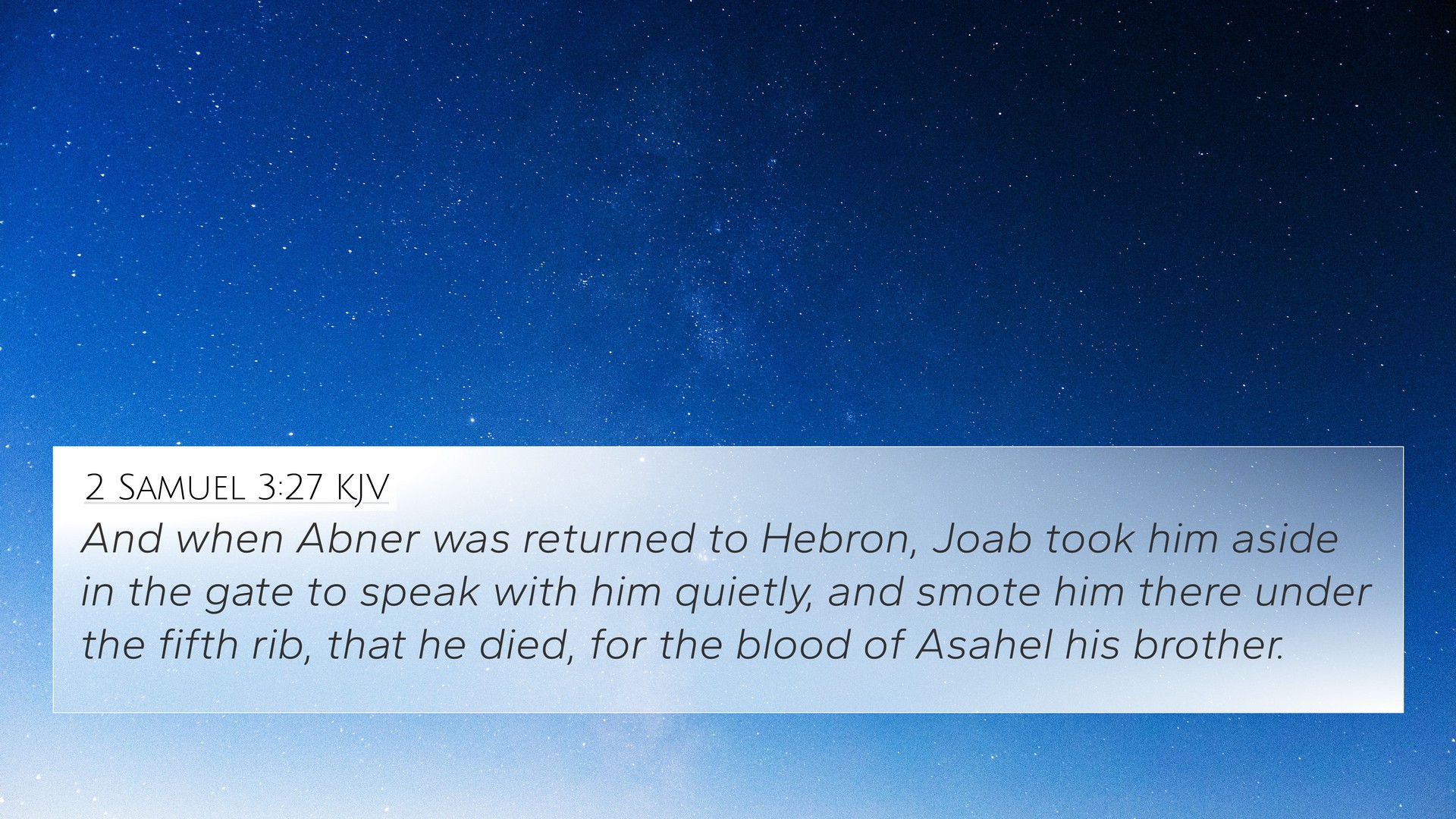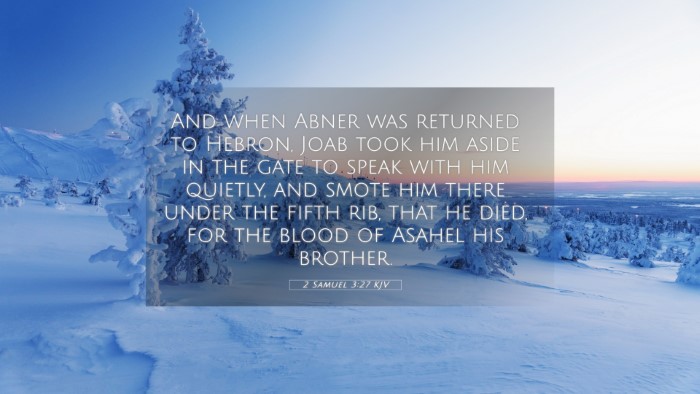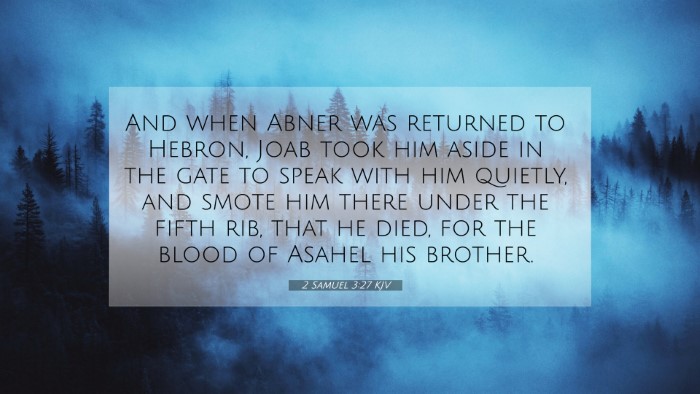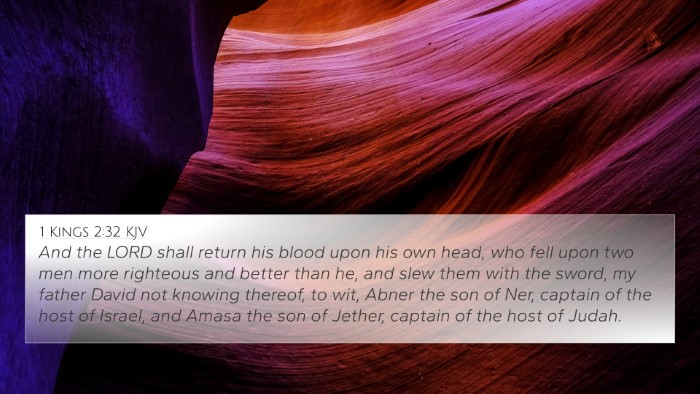Understanding 2 Samuel 3:27
Verse: 2 Samuel 3:27 - "And when Abner was returned to Hebron, Joab took him aside in the gate to speak with him quietly, and smote him there under the fifth rib, that he died for the blood of Asahel his brother."
Summary and Meaning
This verse captures a pivotal moment in the narrative of David's rise to power. It reflects themes of revenge, the consequences of conflict, and betrayal.
Key Insights
- Joab's Motivation: Joab killed Abner out of vengeance for the death of his brother Asahel during a previous confrontation (2 Samuel 2:23). Matthew Henry emphasizes that Joab's act was premeditated, indicating a deeper personal vendetta.
- Abner's Role: Abner had been a formidable leader and a peace-seeker. His death signified not only a personal loss but also a major strategic blow to the house of Saul. Albert Barnes notes that Abner's previous attempts to ally with David highlight the tragedy of his violent end.
- The Context of Conflict: The incident occurred at Hebron, a significant location for David. Adam Clarke points out the geographical symbolism of Hebron as it relates to David's kingship and the ongoing civil strife between the houses of Saul and David.
- Symbolism of the Fifth Rib: The manner of Abner's death, being struck under the fifth rib, could symbolize betrayal, as such a strike is lethal yet subtle. This aspect underscores the treachery behind Joab's actions, as he deceived Abner into a false sense of security.
- Consequences of Violence: Joab’s act had repercussions that extended far beyond the death of Abner, impacting David's reign and leading to future conflicts. Henry remarks on the cycle of violence that ensues from personal vendettas in the historical narrative.
- Divine Sovereignty: The event can also be viewed through the lens of God's overarching plan, as it intertwines the threads of leadership and divine judgment in Israel. Commentators often highlight how God works through the actions of flawed human beings.
Cross-References
To fully appreciate and understand 2 Samuel 3:27, it is essential to explore several cross-referenced verses that highlight connections and thematic parallels:
- 2 Samuel 2:18-23: This passage describes the confrontation between Asahel and Abner, laying the groundwork for Joab's vengeance.
- 1 Chronicles 11:47: References Joab’s exploits and establishes the context of his fierce loyalty and bloody actions.
- Matthew 5:21-22: Jesus' teachings on murder and anger echo the themes of vengeance and the spirit of the law.
- 2 Samuel 4:1-12: It continues the narrative of intrigue and assassination following Abner's death.
- Galatians 6:7: A reminder of the sowing and reaping principle, relevant to understanding the consequences of one’s actions.
- Romans 12:19: The call to leave vengeance to God relates to Joab’s sinful path of revenge.
- Psalm 26:10: This verse reflects the idea of betraying innocent blood which resonates with Joab’s treachery against Abner.
Thematic Connections
When exploring the connections between these verses, we can identify significant themes:
- Revenge and Justice: The impulse for revenge that Joab exhibits reflects the broader human struggle with justice and injustice throughout the scriptures.
- Betrayal: Both Joab’s actions and Abner’s death underscore the dangers of mistrust and betrayal among leaders.
- Leadership and Responsibility: David’s role as a leader becomes more complex with the consequences of his followers’ actions, showcasing the burdens of leadership.
- Sin and Consequences: This act of violence illustrates a recurring biblical theme of how sin leads to further sin, creating a cycle of destruction.
Tools for Bible Cross-Referencing
To delve deeper into the significance of 2 Samuel 3:27, utilizing tools for Bible cross-referencing could enhance understanding:
- Bible Concordance: A tool that helps locate specific words and their occurrences throughout the scriptures.
- Bible Cross-Reference Guide: This guide allows readers to see related verses, enhancing comparative Bible verse analysis.
- Bible Reference Resources: Resources such as study Bibles provide verses that connect thematically or contextually.
- Bible Chain References: A method of linking verses that explore related concepts or narratives.
Conclusion
2 Samuel 3:27 serves as a profound reminder of the complexities of human emotions and the consequences of our actions. By examining this verse alongside other related scriptures, we can gain a richer understanding of the biblical narrative and its implications for our lives today.









